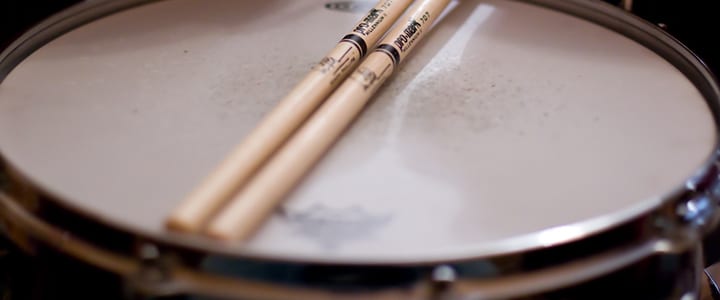As you progress in your drum lessons, you want to learn new songs, but you also want to learn to play with better technique. Here, Detroit, MI drum teacher Joshua J shares his tips to help you refine your drum technique…
When you’re taking drum lessons and practicing on your own, you can make better use of your time by focusing on the things that will help you improve as a drummer.
Proper form and drum technique are essential to improve your sound quality. While this naturally requires patience and practice, it’s not as hard as you think. Here is my three-step process to help you improve your drum technique.
1. Be Efficient
The first step is to make your movements as efficient as possible. Like most things, this is easier said than done. What is efficiency and what makes something more efficient? Efficiency means maximum productivity with minimum wasted effort. So, for our purposes, let’s say that technique is any action achieved with little to no wasted effort. From a single hit to a blast beat, the key to improving your technique is to make every movement more efficient.
To start this process, you have to understand how your body moves. When you go up to the cymbal, are you over stretching or just getting there? Is your right hand doing anything weird when your left hand plays the snare drum, or vice versa? This list can go on and on, but the question is, where is there tension? Try to slow down your movements to find when and where you feel tension, and then try to relax and eliminate the tension.
When I would play a drum set as a beginner, my left foot would tense up as I would play the low tom. When I released that tension from my foot, it made it easier to get to the low tom. When something feels difficult, take some time to figure out why it’s hard, physically. Once you can identify the source of tension, you can find the solution to make it feel easier. Removing tension will improve your technique, and make you more efficient.
2. Listen and Imagine
The second step to improve drum technique is to listen. How well are you keeping time? Are your movements in the groove of the tempo? Can you play the exercises or techniques at any dynamic?
Can you hear those dynamics, rhythms, or tempos before you play them? These questions can be difficult because they all concern the intangible nature of sound. We feel time with our internal clock, and it takes time to develop this skill.
The best way to practice this, is to do drum technique exercises that allow you to hear or imagine the time in your mind. Have you ever played back a scene from a movie in your head, and you could hear the dialogue in your mind? Use the same process with drums; imagine the tempo, with a metronome and then without, and focus on really feeling it, like your own personal downbeat.
3. Develop Your Quality of Sound
After tempo, the next step is to focus on the quality of sound. Being able to do your drum technique exercises at any dynamic will make you more adaptable to different situations. Remember to practice playing softly! You can always add volume later, but if you don’t practice soft, then you will never play softly.
Does your technique sound harsh or nice, soft or hard, thin or thick? Compare your sound with different adjectives or objects, and then imagine what these things sound like. This will help you develop more character in your playing. What does a truck sound like? Imagine the sound in your head, and then play that sound. What does a feather sound like? Imagine it; feel it; play it.
When I got really serious about drums, I wanted to know how every instrument felt at any dynamic, tempo, rhythm, or note length. This forced me to imagine what it felt like to play things efficiently in different categories. At the time, I didn’t understand how my body moved. So, I started to examine how I played hand-to-hand eighth notes. I lifted each stick painfully slow. It took me at least two minutes to get from full height down to the drum, and then three minutes back up to full height, with one hand. During this time, I would ask myself, where is there tension? I focused on relieving the tension in order to make my strokes better.
Again, the key to better technique is to move more efficiently in everything you do, and hear what you do in as many styles and characteristics as possible. Patience is key. Don’t shy away from practicing slowly and softly. Push your limits. Make what you hear, feel, and do automatic, and your actions will be more efficient every time. Remove tension and make playing easier; your technique will improve and you will have more fun playing drums.
Try these drum technique exercises and let us know what you think.
If you’re looking for more drum exercises and technique tips, search here for a private drum instructor near you!
 Joshua J. teaches drum lessons in Detroit, MI. and is an Orchestra Fellow of the Detroit Symphony Orchestra. Joshua received his percussion training from the Chicago Symphony Orchestra Percussion Scholarship Program, and his Bachelor of Percussion Performance from DePaul School of Music. Learn more about Joshua J. here!
Joshua J. teaches drum lessons in Detroit, MI. and is an Orchestra Fellow of the Detroit Symphony Orchestra. Joshua received his percussion training from the Chicago Symphony Orchestra Percussion Scholarship Program, and his Bachelor of Percussion Performance from DePaul School of Music. Learn more about Joshua J. here!
Photo by kamalaboulhosn
Maile Proctor


